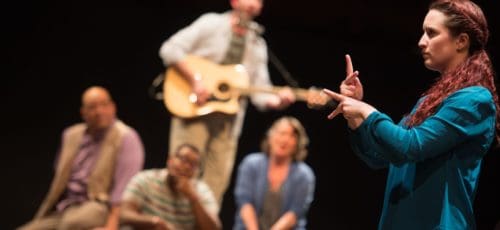My Life in [Performance] Art
Theater artist Domenick Scudera begins a regular column about his experiences in the performing arts.
Performance art is easy. You get onstage, share comic yet painful childhood memories, strip naked, smear chocolate on your body, and you are done. If you want, you can throw in a few innovations. Tell about your painful teen years wearing nothing more than communion wafers on your nipples while sitting in gynecological stirrups strapped to a bobsled dipped in a vat of urine. Anyone can do it. Who are performance artists anyway? Out-of-work actors doing cheap marketing stunts by being provocative, right?
That is what I used to think. I have since discovered that none of these perceptions are true. Performance art is not so simple, and good performance artists are not failed performers vying for attention. They take the “Art” part of performance art seriously. Effective performance artists weave their life experiences into something memorable and meaningful. Smeared chocolate represents layers of difficulty. Communion wafers are a metaphor for a confused spirituality. Performance artists place their othered lives front-and-center in creative, poetic ways. The performances may be uncomfortable and weird, but they are noble. There is a larger purpose to “exposing” yourself and sharing your differences.
I see the nobility and complexity in performance art because I have actually tried to do it myself. It is not easy. How do you go about selecting and editing parts of your life? In everyday life, people think whatever they want about you. In performance art, you construct your own identity and decide what you want people to think about you. This is a much more daunting task than it appears to be.
One Philly Fringe season, I decided to throw my hat into the ring and create my own performance piece. I figured I was secure and comfortable enough in my own skin to pull it off. But what was it going to be about? Was my life all that interesting? What kind of formula would I follow? My brand of performance art probably would not include nudity or urine, so what was I going to do?
It dawned on me that my life is somewhat unique in one respect: I am a man who likes to wear kilts. Since it is fairly unusual for a man to wear any kind of skirt in America these days—particularly a man of Italian heritage—this seemed like a distinct perspective from which to build a performance piece.
A man in a kilt is continually asked the same two questions: 1. “Are you wearing any underwear?” (this can take other forms like “Are you going commando?” or “Is it drafty down there?”) and 2. “Why are you wearing that?” (often followed by “Are you Scottish?” or “Is there a costume party?”) The goal of my performance piece would be to answer these questions. If I could talk in front of a whole audience at once then I could avoid having to answer every person individually. Okay, not exactly provocative or shocking. But my performance would be, at the very least, practical.
So I set about writing my own little art piece. It was fairly easy to jot down crazy things people had said to me (“Where’s your bagpipes?!” or “You are attractive . . . from the waist up.”) but what else? How could I develop this? I do not have any painful childhood stories. Can you be a performance artist if you had a happy upbringing? I reached deeper. I had to examine myself. Why do I like to wear kilts? What does this say about me? Who am I? What is Life? What does it mean to be Human? What is the Universe?
This was exhausting.
Examining yourself for material is a mind-blowing experience. It now made sense why bad performance art can feel like a therapy session. I managed to unearth one embarrassing childhood memory of when I was once mistaken for a girl. It took me years to feel comfortable wearing (or doing) anything that might be considered remotely “feminine.” I kept mining my memory for more material and eventually patched together enough to create a first draft.
I rehearsed in front of friends. Some sections they liked. Other parts made them cringe. It was good to know early in the process that I might be humiliating myself. It was also difficult to be so vulnerable in front of friends. But they were understanding and constructive. The piece started to find shape and ended with what I thought was a meaningful and oh-so-clever little monologue:
“We all have our thing. Some people have blue hair. Or tattoos. Some people like to wear leather. We all express ourselves in different ways. Do you know what your thing is? Mine is just a simple kilt. It doesn’t hurt anyone, it makes me happy, brightens my day. So why not? If you have identified your secret thing—your own personal kilt—I say go ahead and try it, wear it, sign up for, go for it! Life is too short I say: Kilts Forever!”
That was the title: Kilts Forever. I had done it! I was an Artiste with a capital A! I had woven stories from my life and crafted a moral, dripping with meaning, about not caring what others think of you. I was ready for my Performance Art debut!
I was booked to perform on a split bill with other artists at a Fringe venue that was a factory turned into a bar transformed into a tiny performance space. It was dank and smelled like stale beer, but I thought it was glamorous. It linked me to other performance artists like Holly Hughes or Tim Miller, people whom I was sure had also performed in similarly disgusting venues and had persevered.
I had precisely thirty minutes for a technical rehearsal before the audience arrived. My Art included just a few light and sound cues. A tech guy ran the lights, and my partner Brian graciously agreed to operate the sound. Gracious because Brian had created his own performance art piece (about his scars), too, and he had to perform immediately after my piece was over.
The audience arrived. The time had come! The lights went out and I took my place on the stage. And . . . panic!. Suddenly I did care what people thought of me. Am I a fraud? What was I doing? Could I really expose myself to a bunch of strangers? I needed to calm my nerves. I remembered a good piece of theater advice: focus solely on the opening moment. If you can get through that one second in time, the toughest part, then the rest is pie. This worked to settle my breathing. Opening moment. Opening moment. In the dark, I concentrated on what I had planned:
Lights up on DOMENICK in a kilt, full Scottish look. Scottish dance music begins. DOMENICK dances Riverdance-style. As he really starts to get into it, the music stops abruptly.
DOMENICK: “Hey!”
VOICE (Brian): “You’re not Scottish.”
Theme from the Godfather plays.
The lights came up. The audience was looking at me. I was chock full of my Scottish dancer-y attitude. My heart was beating very, very fast. Now the music would start and I could get past this hurdle.
No music. Faint, scratchy feedback emanated from the speakers. Should I start dancing? Awkward. A deer in headlights. What should I do? I kept thinking, “Get through the opening moment.” So I started to dance. The audience will figure it out, right? The static noise stopped. Silence. I stopped dancing. It was so quiet. Except for my heavy breathing. The audience’s attention was drawn to the tech booth. Brian and Tech Guy were arguing and popping the music disc in and out of an outdated stereo tray. Oh my god! I cannot even get through my opening moment! Now what?
Blackout. Tech Guy put me out of my misery.
I heard a few nervous giggles in the audience. I am not particularly good at improvisation, but it sure felt like someone should say something. So, with my best Charles Nelson Reilly sarcasm, I said wryly: “Welcome to the Fringe Festival.” It proved the right thing to say. Everyone knew the factory/bar/stage space was lacking, and the opening snafu just confirmed the Fringe-y quality of it all. People laughed. The ice was broken.
Suddenly the music came blaring over the speakers, making the audience jump. I was surprised and relieved all at once. The audience broke into a long sustained applause as the lights came up. They were just as happy to see me get out of this private hell as I was. My Fringe nightmare was over. The warmth coming from the audience was fantastic. I felt their sustained support through the entire piece. For me personally, this was Fringe at its best.
And that entire evening not one person asked me if I was wearing underwear.
—Domenick Scudera is the chair of the theater and dance department at Ursinus College. He regularly directs plays for many theaters such as the Philadelphia Shakespeare Theater and the Delaware Theater Company, and is a member of the Waitstaff Sketch Comedy Troupe.



